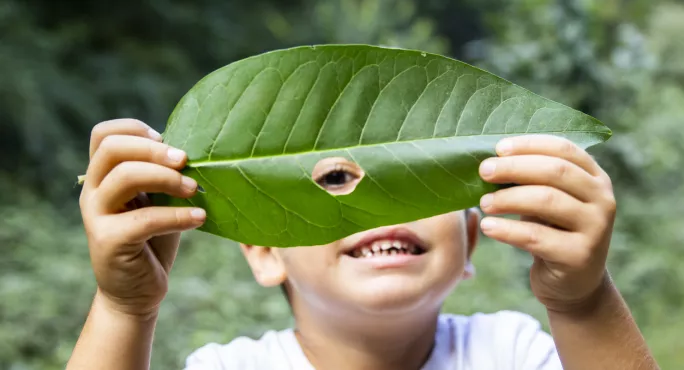4 fun and impactful ways to teach EYFS maths outdoors

This academic year I identified an area of professional development I wanted to explore: outside learning.
After years of living in an extremely hot environment, I had effectively stopped thinking about using the outdoors as a classroom. However, living in a country with four seasons, I felt it was time to begin to use the outdoors in my teaching.
To enhance my practice, I researched outdoor learning and followed suggestions from the training programme Muddy Puddle Teacher, and focused much of this on maths, which was a dream to teach outside.
Furthermore, I found that many other areas of the EYFS curriculum could be covered in conjunction with maths. This is what I consider to be the major benefit of outdoor learning. Here are some basic suggestions to get you started on maths outside:
EYFS: Maths outdoor learning
1. Measurements
There are many opportunities for size comparisons with objects such as twigs using the language of longer/shorter/longest/shortest in context.
This also fitted well with one of our units, Stick Man, where we created a stick family and discussed the relative heights in context (by standing the sticks up vertically). I found that the children very carefully compared their natural items as they had ownership of the items. They took their time and were very focused in this task.
We also measured objects in the playground using handspans and our feet. This was very motivating as outside surfaces are larger than in class. The children really enjoyed finding out the “big” distances.
Doing this outside really resonated with the children, far more than if we had tried to replicate this indoors.
2. Patterns
Encouraging the children to gather natural objects, count the quantity (ensuring that they have more than one of the same item) and then create repeating patterns was a highly enjoyable activity for my class, as searching for items became a “treasure hunt”.
Sticks and stones are great to feel compared with plastic counters, and when natural objects are used language is explored, as children discuss how the textures feel or the objects look.
As the natural objects do not conform to uniform shapes and sizes, the children explained that “this leaf is a bit bigger than this one but it is the same colour” or “this is a pattern of things, not colour”.
I witnessed the children exploring the objects with their senses, using language such as “bumpy and not bumpy” when describing their patterns.
You could find ways to do this in class, of course, but the natural world provides such a variety of materials, it’s a resource that cannot be surpassed.
3. Positional language
One way to teach this is by lining the children up outside and counting each one, giving them their ordinal number. I then ask questions like “who is first?” or “who is before the sixth person?”
I do carry out these activities in class, too, but the children seem far more motivated to engage, look around and get involved outside as there is much more to take in - for example, asking:
- “Who is sitting between (name) and (name)?”
- “What can you see next to the tree?”
- “What can you see in front of the climbing frame?”
4. Numbers and movement
A fun outdoor maths game that we have enjoyed playing is “one more/less than 20”.
For example, you can say: “When you hear a number one more than 10, you can run to the wall,’ or, “If you hear a number less than 8, you can jump in the air.”
You can also adapt the game to match movement to number. For example, jump 10 times. Check the children can match the movement to the jumps. Then you can extend the game by jumping 10 times and one more, or instruct them to hop one less than seven.
The ability for the children to move around in a big space is so much more practical than working within the limited space of a classroom.
Overall, I have really felt that learning outside has had a great impact on my class. This is now a feature of our weekly plans, in which we include subjects such as phonics and English.
At times some of the above is simply taking an indoor idea outdoors - but the children’s enthusiasm to listen, engage and participate when outside is clearly enhanced, and their learning improves, too.
Jess Gosling is a teacher at the Taipei European School. She can be contacted via her website or Twitter @JessGosling2
Register with Tes and you can read two free articles every month plus you'll have access to our range of award-winning newsletters.
Keep reading with our special offer!
You’ve reached your limit of free articles this month.
- Unlimited access to all Tes magazine content
- Save your favourite articles and gift them to your colleagues
- Exclusive subscriber-only stories
- Over 200,000 archived articles
- Unlimited access to all Tes magazine content
- Save your favourite articles and gift them to your colleagues
- Exclusive subscriber-only stories
- Over 200,000 archived articles